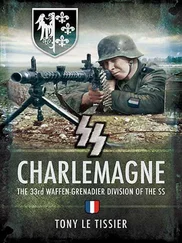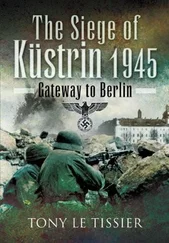I was therefore to remain here, first constructing barricades on the upper level behind which we could entrench ourselves and conduct an all-round defence. Should the Russians break in, they would have to be dealt with quickly. We did not know from which entrance the Russians were likely to appear, so we had to have an all-round defence.
Meanwhile, above on the square, a vast scrap yard had formed of burnt-out abandoned vehicles and shot-up equipment strewn everywhere.
My attention now turned to our sector from Belle-Alliance-Platz to the Potsdamer Bridge. The situation at the bridge was still as previously described with an aerial mine suspended from either side and the bridge unblown. The bridge was stormed by the 79th Guards Rifle Division, supported by tanks of the 11th Tank Corps. Sappers had first to neutralise the mines, which cost them heavy casualties from our machine guns. We also fired our mortars and rockets as directed by our forward observer in the immediate vicinity, whose radio worked perfectly.
The Russians later made a big thing of the story that a child crying for its mother was rescued by the standard bearer of the 220th Guards Rifle Regiment at the risk of his own life, but the forward observer reported nothing of this and I think that it was just another one of their propaganda stories. [52]
The enemy infantry first advance under cover of a smokescreen, which enabled them to establish a small bridgehead. Then the tanks tried a new trick that our comrades fell for. The first tanks were shot up by the ‘Nordland’ tanks firing from the Tiergarten, where they were immobilised for lack of fuel. The Soviet tanks had protected themselves with sheet metal and other items against Panzerfausts, so one of them threw sacking over these projections and soaked it with fuel then set it alight to make the tank appear as if it had been hit, which enabled it to get across and take up position without being fired at.
Simultaneously the infantry of the 39th Guards Rifle Division swam across the canal and got up the embankment, while the 12th Motorised Rifle Brigade did the same thing at the Möckern Bridge U-Bahn Station and were suddenly on our side of the canal. Our defending troops were taken by surprise, but counterattacked vigorously and drove some of the Russians back into the canal. Unfortunately not everywhere, only where we had energetic leaders.
Further to the east at the Hallesche Tor the Russians were able to get some tanks across by means of pontoons, but as soon as they got their tracks on to firm ground tank destroyer units engaged and destroyed most of them.
The Russians could no longer use their aircraft against us as the lines were too close, barely two metres separating the antagonists in some places. In some buildings the Russians fought from the lower stories with Germans above them, and I would have to clear the lower stories myself before handing over my stragglers. My British sub-machine gun proved excellent for this close quarter fighting. At a range of thirty metres it was the best weapon going. Hardly any prisoners were taken under these circumstances.
Every reinforcement was gladly received by my comrades, who also welcomed the food and ammunition we brought with us. It was not so easy replacing defective machine guns. We had established an armourer’s workshop in one of the S-Bahn carriages, but it was usually only possible to assemble one effective machine gun out of two defective ones.
The night of 28 April heavy fighting took place around Leipziger Strasse and Prinz-Albrecht-Strasse, where the Gestapo HQ was strongly defended. The Russians tried to break through here and succeeded briefly but the Gestapo counterattacked and regained their building. I always gave this area a wide berth to avoid these gentlemen laying their hands on me, and now they were having to fight for their lives.
29 April came and we were having to hold on to our positions and conduct counterattacks, all to little effect. We only knew through rumours of the big political decisions being made in the Reichs Chancellery, so I went across to see what I could find out. The battalion commander and his staff came with me. He too was not informed of what was going on, being too junior, but SS-Brigadier Mohnke was well informed, having had two meetings with Hitler that day. He told Hitler that the Russians were already at Potsdamer Platz and in the tunnels under Voss-Strasse, but that was not true, for the area around was still firmly in our hands.
The Russians finished their assault on the Ministry of the Interior at about 0400 hours on 30 April. I had had to send a forward observer back there, for the battalion commander had forbidden me to go myself. I had told my NCOs on no account to let themselves become cut off in the Ministry of the Interior. If the Russians found their field cable they would cut it and render it useless. So they went to the Swiss Legation building and stayed there until forced out by the 171st Rifle Division clearing the western half of the Diplomatic Quarter.
We had now used up the last of our mortar bombs and there were no more available, so I sent a runner to recall my men. I also recalled the observer from our left flank for the same reason. Now that we were ‘unemployed’, I used my NCOs for taking forward stragglers, and from the reports they brought me on their return I gained the following picture. The Russians had occupied both sides of Leipziger Strasse and had also occupied the Anhalter Station. The pressure was increasing as they closed in from all sides. The Zoo Bunker and its surrounding area was cut off from us and formed its own ‘pocket’. Several stragglers from there got through the Russian positions to us at night and reported that barricades in the area manned by Hitler Youth and Volkssturm had been attacked by the Russians using 45mm guns at point blank range and then the Russians had forced civilians out of their cellars to clear them under German fire. Now that things had hotted up at the Zoo bunker, some of the civilians sheltering there had been driven out, thousands suddenly emerging into the open looking for cover and protection, and had come under fire from the Russians as they left the bunker. [53]Some of them got through to us and reported how terrible conditions were inside the bunker. There was hardly any air to breathe, the guns were constantly firing, and the screams of people breaking down under the strain made it unbearable. In contrast to the Zoo bunker they found the conditions in our tunnels quite pleasant. Even though there was not much room, they could still walk about and move around a bit. We had to supply these newcomers with water too, but there they had only received a mouthful from time to time.
THE BATTLE FOR THE REICHSTAG
This was a real battle in itself. I cannot describe it from my own experience but only from that of surviving combatants and also Russian reports, although the latter should be treated with great caution.
The commander of the defence at the Reichstag was SS-Lieutenant Babick of our battalion, who came from the same 2nd Regiment of the ‘Leibstandarte Adolf Hitler’ as I did, where he had previously commanded the 11th Company of our 3rd Battalion. After hospitalisation he had taken over the Potential Leaders Company at Spreenhagen in February 1945. I am not sure, but I think it was that company that he had at the Reichstag. The company was about 100 strong and he received no more support from our battalion commander. To this can be added the 250 sailors that had been flown in though, as previously mentioned, these men were not properly equipped for combat. We called them ‘The Dönitz Contribution’ and the accompanying naval officers acted as his platoon and section leaders. Then came the company of paratroopers from the 9th Parachute Division, plus the approximately 100 Volkssturm stragglers that I brought him. So in all Babick had a force of no more than 550 combatants at his disposal, as opposed to the 5,000 attributed to him by the Russians.
Читать дальше












